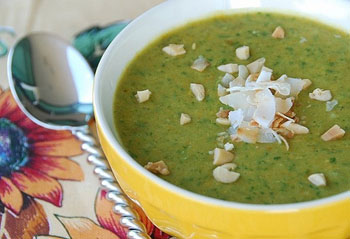 It happens every week. As I'm selecting my Swiss chard, kale, or collards, someone inevitably sidles up to me and asks, "What do you do with that?" Then after I share a recipe idea, she usually follows up with, "To me, they're all the same."
It happens every week. As I'm selecting my Swiss chard, kale, or collards, someone inevitably sidles up to me and asks, "What do you do with that?" Then after I share a recipe idea, she usually follows up with, "To me, they're all the same."
No wonder people get confused. Every time you go to the supermarket all the winter greens are mixed together in one big, undivided, forest green section, with seemingly randomly placed signs and prices scattered above and below them. It's like a game: Match the green on the left column with the correct name and price on the right column. Chances are you probably just select the green that your mom made when you were growing up because it's the one you actually know how to cook.
Well here's a tip that will make you look like a savvy supermarket shopper. Buy red kale. It's the one winter green that you can always correctly identify. Red kale has red tinged curly, oak shaped leaves with a dramatic purple vein down the center. There's no mistaking it for collards.
 So next time you're at the greens section and everyone else is desperately trying to figure out what's what, casually stroll over, pluck a head of brightly colored red kale off the shelf and place it in your cart. Don't hesitate or glance up at the signs. Stay cool. Then head to the check out aisle. Mission accomplished.
So next time you're at the greens section and everyone else is desperately trying to figure out what's what, casually stroll over, pluck a head of brightly colored red kale off the shelf and place it in your cart. Don't hesitate or glance up at the signs. Stay cool. Then head to the check out aisle. Mission accomplished.
Red kale is a type of Russian kale that is super high in vitamins K, A, and C and may even help prevent cancer. Unlike other members of the brassica family, such as green dinosaur kale and mustard greens, red kale's flavor is more sweet than bitter, and its leaves are more tender. Red kale can be eaten raw in salads or it can be steamed, boiled, or sauteed. If you have a small refrigerator and don't want to take up half a shelf with a bunch of kale, then par-boil it and store it in an air-tight container for up to 5 days.
Curried Red Lentil, Chickpea, and Red Kale Soup
This healthy Indian-inspired red lentil soup is enticingly aromatic and flavorful. Top it with a garnish of toasted coconut and chopped peanuts for a little crunch.
Makes 4-6 bowls
Soup:
2 tablespoons olive oil
1 large yellow onion, diced
2 medium carrots, peeled and diced
2 celery stalks, diced
1/2 bunch red kale, center stalks removed, and finely chopped (about 2 packed cups)
1 cup red lentils
1 (15 oz) can chickpeas, drained
4 cups low-sodium vegetable broth
1 (15 oz) can light coconut milk
2 teaspoons hot curry powder
1 teaspoon yellow mustard seeds
1/2 teaspoon garam masala
1/2 teaspoon ground coriander
1/4 teaspoon cayenne pepper
1 tablespoon fresh ginger, minced
several shakes of salt, to taste
Garnish:
1/4 cup lightly toasted unsweetened coconut
2 tablespoons roasted unsalted peanuts, finely chopped
Heat olive oil in a medium saucepan over medium heat. Add onion, carrots, and celery; sauté until golden, about 5-7 minutes. Meanwhile bring a large saucepan of water to a boil. Add kale; boil for 2-3 minutes, then drain. (This will make it more tender). Add drained kale, lentils, chickpeas, and broth to the carrot mixture; bring to a boil. Cover, reduce heat to low, and simmer 12-15 minutes or until lentils are tender.
Pour half of the lentil mixture into a blender; let stand for 5 minutes (so the soup will cool and not cause the cover to pop off!). Pour pureed lentil mixture into a bowl, and repeat process with the remaining half. Once the soup is blended, return to the pan; add coconut milk, spices, ginger, and salt; stir well. Cover and simmer for about 10 minutes or until thoroughly heated through. Remove from heat; season to taste with salt. Ladle soup into bowls and garnish with toasted coconut and peanuts.
Susan Russo is a free lance food writer in San Diego, California. She publishes stories, recipes, and photos on her cooking blog, <Food Blogga and is a regular contributor to NPR’s <Kitchen Window. She is also the author of two upcoming books that will be published in the fall of 2010.

